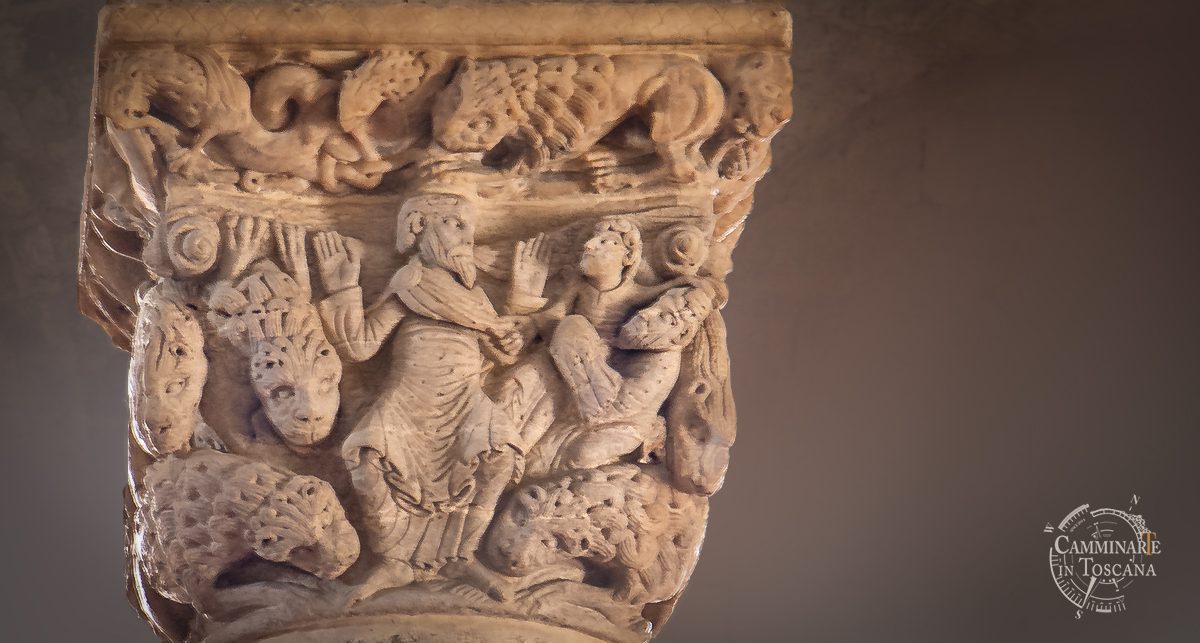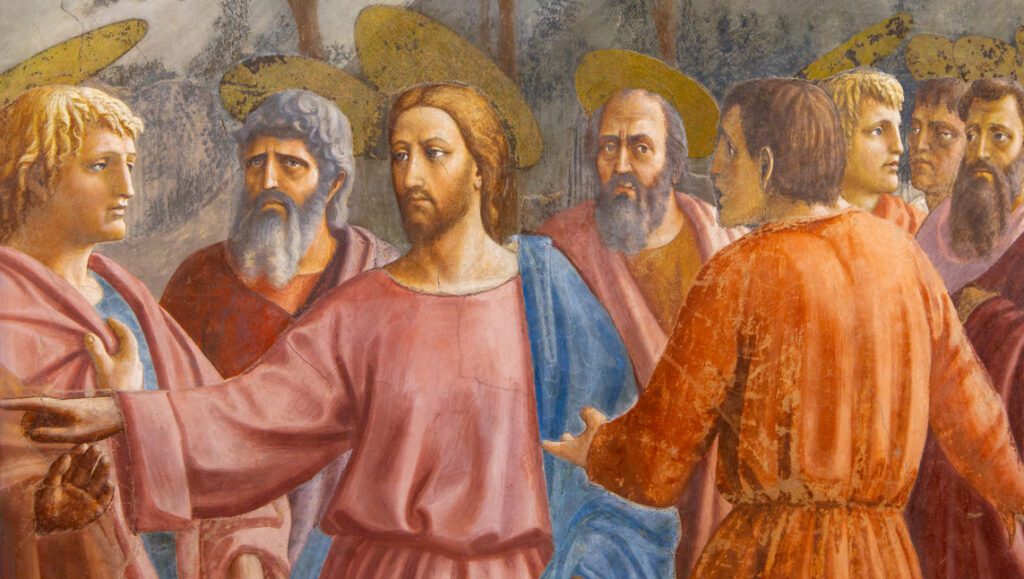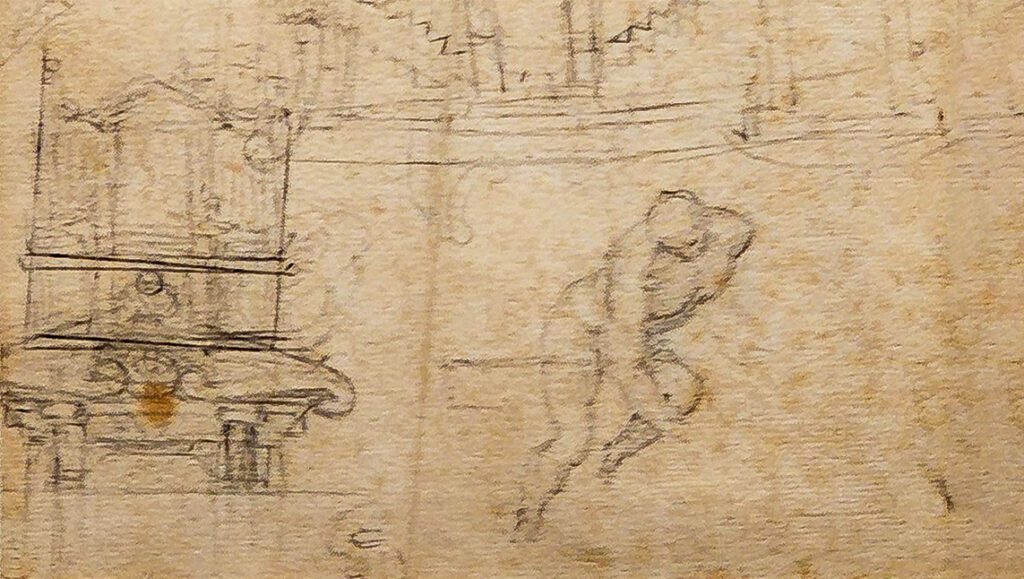A visit to the Sant’Antimo Abbey to discover its treasures
It occurs that one thinks on the Terre di Siena (Siena lands) not without a note of amazement and wonder, bringing to mind striking images of hills dotted with picturesque farmhouses and cypress-lined avenues.
The sense of wonder intensifies when one discovers that in this region of Tuscany there exists a fascinating place like the Sant’Antimo Abbey, where even today the most expert scholars, in the disputes of art history, recall the extraordinary presence of particularly evocative sculptures.
We are in the southern Province of Siena, in the municipality of Montalcino, and the Sant’Antimo Abbey is a building of remarkable interest, not only for being a magnificent example of Romanesque architecture still well preserved – despite the many vicissitudes that it has crossed over the course of its centuries-old history – but also for constituting the treasure chest containing signs coming from a remote past, engraved in the local travertine and onyx stones, elegantly laid out in the great architecture of the abbey church, dating back to the 12th century.
The evocative signs to find by the visit to the Sant’Antimo Abbey
Although scratched by time, the images that can still be admired in the abbey are of extraordinary evocative power: where a ray of sunlight hits the surfaces, in the precise point where whoever decided to place the sculptures knew this phenomenon occurred, it is where the sign engraved in the stone stands out most.

View of the Sant’Antimo Abbey with the nice valley in which it is immersed
It can be said that the visit to Sant’Antimo is an experience full of sensations and emotions that affect the non-superficial visitor from the first sight of the abbey, when one arrives in the valley in which the monastery is immersed, coming from Montalcino road.
When you approach the monastery, the first thing you see is the back of the church – and not the facade -. This almost gives the idea that the place you are going to visit wants to hide something precious, wrapping itself around itself and almost protecting itself from those who come here just to steal some sensational photos: discovery – the real one – requires perseverance.
It may happen that, once you have left your car in the car park near the church – or unloaded your backpack on the ground if you were lucky enough to get here on foot -, you remain a little disappointed by the extreme sobriety of the facade; looking more carefully, however, you notice that there is an inscription on the stone entablature of the entrance portal: this tells us about the construction of the church on the initiative of an important character of the 12th century.
The animals carved by an only head
Glancing up, the figures of sculpted pairs of animals, sharing a single head, appear before our eyes. According to some scholars, the animals depicted here, with a stylised shape, are panthers and the only head they share has a particular meaning.
Other zoomorphic images are present along the entire perimeter of the church; focusing attention instead on the inside, where one can access by crossing the entrance portal where we have already seen the inscription and the stylised figures of the panthers before, one cannot help but perceive the impressive energy radiating from the place, a sensation visitors have regardless of what one’s religious beliefs may be.
If so far we have only mentioned the interesting figurative repertoire of the Sant’Antimo Abbey, let’s now see the reasons why this peculiarity is so worthy of interest.
In the description found in the texts that deal with the complex, the most recurring element is the comparison of the Tuscan abbey to the models of French Romanesque, specifically Cluniac.

Beyond the purely technical issues of this report, which have been dealt with by specialists of whom I leave some references in the bibliography, the probable Sant’Antimo closeness with the Romanesque world beyond the Alps is certainly high-sounding and has a raison d’être: upon entering the church, what one sees in particular – and which finds resonance in the French models – is the presence of the ambulatory, that is, the semicircular gallery running along the apse of the main altar.
By facing the view of the interior of the church, a component that significantly contributes to perceiving that energy mentioned above is the light filtering through the windows: it is precisely the ambulatory that amplifies the presence of light inside the church which, thanks to its three apses, brings together an intense luminosity in the building that can be said mystical.
The capital of the sculptor coming from France
The other particularly ‘French’ element of the Sant’Antimo Abbey is the second right capital of the central nave, which shows Daniel in the lions’ den and is attributed to the so-called “Master of Cabestany“.
Personality rediscovered in the 1930s, thanks to the finding of a 12th century sculpted tympanum in the French town of Cabestany – from which the artist conventionally takes the name assigned by critics –, to this anonymous sculptor – or to this series of workers following the same stylistic features of a plausible master – a group of works are attributed and they can be compared due to great stylistic affinities, ranging from the French Pyrenees to Tuscany, where this capital is present, together with other works found in San Casciano Val di Pesa and in Prato, passing through the Eastern Pyrenees and the North of Catalonia.
The style of this master is recognisable by the creation of triangular-shaped faces, low foreheads, high and sunken ears, elongated almond-shaped eyes, hands with long and thin fingers.
Daniel in the lions’ den
The episode carved on Sant’Antimo capital draws on the Bible, specifically from the Book of Daniel, in which we learn the wise prophet, in king Darius of Babylon’s service – or Cyrus, depending on the chapters of the same Book –, was saved by God in the lions’ den where the king had sent him after the allegations made against him by two jealous advisors, due to the alleged Daniel’s disobedience to a king’s law. In the Sant’Antimo capital one sees how Daniel is assisted in the den by Habakkuk – another prophet – carried by an angel to Babylon, where he feeds Daniel left without food.
The biblical story ends on the capital in the rear part, where the bad counsellors are featured devoured by the wild beasts in the pit, thrown there by the king upon he finds Daniel unharmed and understands the prophet is protected by God and had been unjustly accused.
The great charm of this work lies in the richness of details, in the rarity of the theme (it is not usual to find this subject in the history of art), but also in the unusual location of the capital, placed almost at the beginning of the right side of the nave, in a much more secluded position compared to the centrality of the main altar. This dislocation is only apparent since this is a point of the church that is crossed by the sun’s rays in a particular period of the year, a phenomenon that has very precise symbolic meanings and of which the Benedictine monks, who lived in this place for several centuries ago, were well aware of it; this phenomenon can still be appreciated today by the visit to the Sant’Antimo Abbey.

What a capital created by a French sculptor is doing in the heart of the Val d’Orcia is something that finds reasons linked to the great history of this monastery and that of the nearby religious realities.
Secondary in technical quality – but not in symbolism – are the other historiated capitals adorning the church, all aimed at creating a concert of messages that were well known to the inhabitants of this complex in the Middle Ages and which today need to be deciphered through reading of the texts, edited by the scholars who have dealt with them, or by a guided tour.
The clues that I have left so far make it clear that the visit to the Sant’Antimo Abbey proves to be an extremely interesting and unmissable experience for those who find themselves traveling in the beautiful Lands of Siena ⟣
Bibliography and Webliography
- W.Angelelli, F.Gandolfo, F.Pomarici, Aula egregia: l’abbazia di Sant’Antimo e la scultura del 12. secolo nella Toscana meridionale, Napoli, Paparo, 2009 (Italian edition);
- Abbazia di Sant’Antimo (a cura di), Una pietra che canta: guida storico-artistica illustrata, con presentazione della comunità dei canonici regolari di Sant’Antimo, Siena, Cantagalli, 1993 (Italian edition);
- Daniele e i leoni, un Cabestany eccelso, Before Chartres,(Italian edition), consulted on 04/12/2023;
- Maître_de_Cabestany, Wikipedia, (French edition) consulted on 04/12/12/2023;




